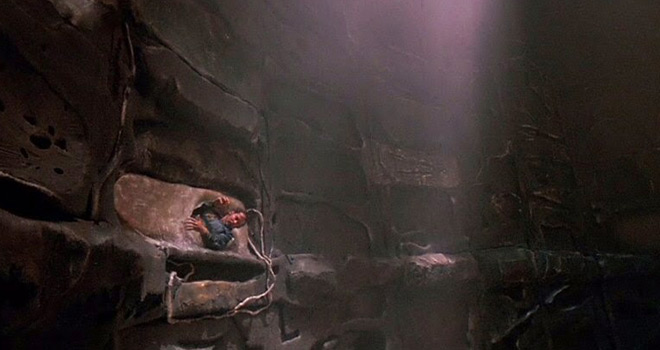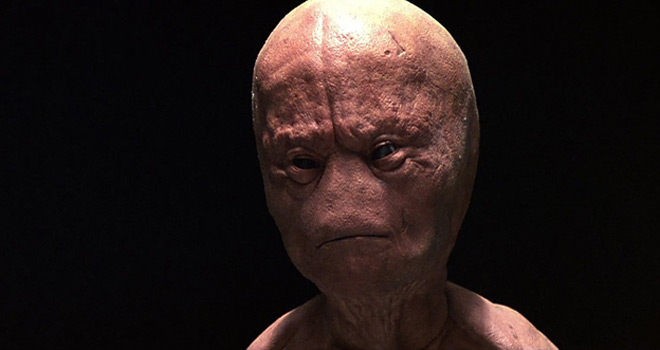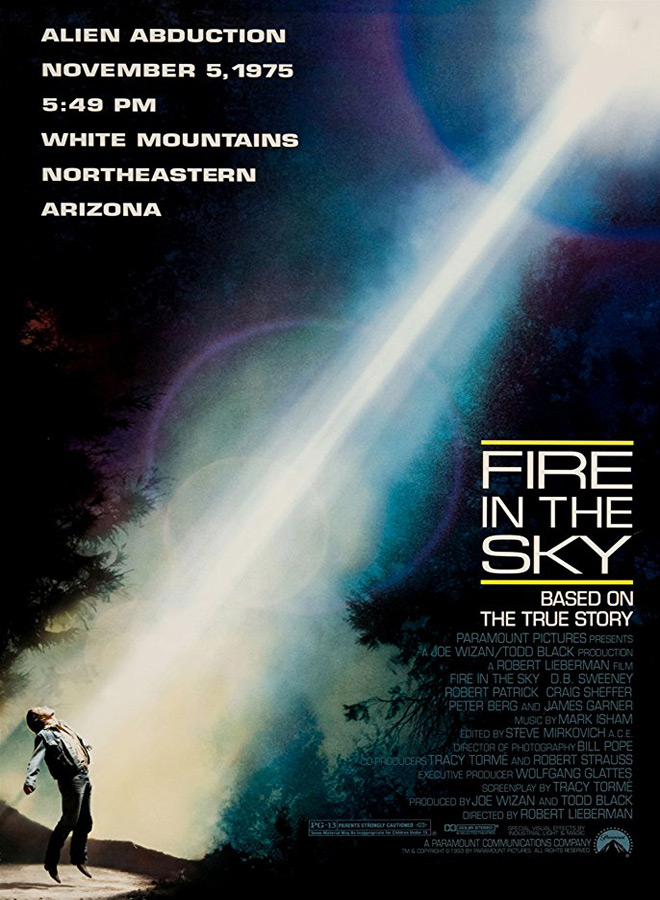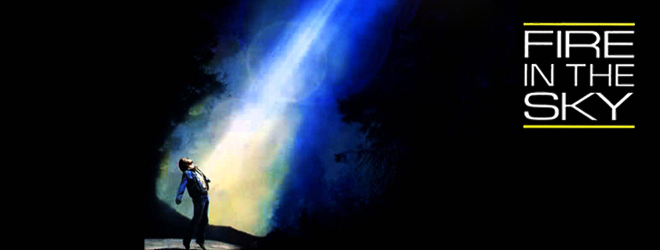When it comes to films about allegedly non-fictional alien abduction cases, the two standouts tend to be 1989’s Communion or 1993’s Fire in the Sky. The former was based on the book about Author Whitley Strieber’s close encounters with grey aliens and more in 1985. The latter is based in 1975, when a UFO abducted Arizona logger Travis Walton. He was knocked out after a fight with its crew and dropped off on a nearby highway, where he was found a few days later.

Walton later wrote of his experience in his own book, titled… er, The Walton Experience. It later served to inspire the film Fire in the Sky, released on Friday, March 12, 1993. Distributed through Paramount Pictures, they decided to have Screenplay Writer Tracy Tormé (Star Trek: The Next Generation series, Intruders 1992) spice up the story a bit for the big screen. Why? Well, because Walton fighting three “short, bald creatures” and helmeted humanoids felt “too fuzzy and too similar to other televised close encounters.” Almost every true story gets embellished one way or another for the big screen. Walton was against these changes. In fact, he has insisted on telling the warts-and-all truth since day one. Or at least what he believes and/or wants others to believe.
The sheriff had Walton and co undergo their first polygraph test under Examiner Cyrus Gilson. All passed, except for one friend whose results were inconclusive. Then, the National Enquirer put Walton and his elder brother Duane to the test, as they went to claim the paper’s cash prize for proving aliens existed. They ended up failing the test, but the Enquirer promised not to publish the results. Local UFOlogists conducted a third test, where the results were promoted as a pass despite being inconclusive. Then a fourth one – arranged as part of the film’s publicity campaign and overseen by Gilson once again – said Walton and his friends were telling the truth. Funny how the one clean sweep happened right when there was a movie to promote.
Not that lie detectors are the only discrepancies in the story, but, for the sake of brevity, let’s cut to the chase; it does not stand up to scrutiny. Walton & co most likely spun a yarn to get some publicity and some extra cash on the side. Though it has certainly helped him out with UFO enthusiasts and cheap TV via appearances on The Moment of Truth in 2008 and Ghost Adventures in 2016. There is a reason why his life-changing encounter/publicity stunt is now known as the Fire in the Sky instead of The Walton Experience. True or not, it managed to inspire a film that has become a cult favorite. Does it still hold up after 25 years?

The story is fairly close to the original. Travis Walton (D.B Sweeney: Brother Bear 2003, The Resurrection of Gavin Stone 2016), his future brother-in-law Mike Rogers (Robert Patrick: Terminator 2: Judgment Day 1991, Scorpions series), and their friends work as loggers in the White Mountains of Arizona. On their way home from work, they see a flying saucer in the sky. Walton goes for a closer look, gets struck by a beam of light from the saucer, then disappears. Rogers and the others are accused of murdering him, until he is found 5 days later. At first, he does not remember what happened… until it all comes flooding back. Directed by Robert Lieberman (The X-Files series, Falling Skies 2015), it received 4 nominations at the 1994 Saturn Awards, including Best Actor for Patrick and Best Writer for Tormé.
It certainly has plenty going for it. It starts off hinting at its alien origins, with a slow intro featuring a glowing light in the sky… that turns out to be car headlights. Also, Lieutenant Frank Watters (James Garner: The Great Escape 1963, The Notebook 2004) looking up at some glowing lights reflected on his car windshield… that ends up being from a rail crossing. Then, the UFO does arrive, and takes Walton away to some unknown, unprovable fate. Patrick’s Rogers’ explanation to the police does not help things, and leads to the film’s best dramatic scenes.
For example, it creates a public backlash that affects Rogers’ wife Katie (Kathleen Wilhoite: Pay It Forward 2000, Crazy Kind of Love 2013) and his family. Then, Watters’ probes Rogers for information about fellow logger Allan Dallis (Craig Sheffer: Nightbreed 1990, Bad Ass 2012) and his animosity towards Walton. The rising paranoia works as build-up to the first polygraph test, depicting it as the one thing that could help clear the air. At least until Walton returns.

Patrick does a heroic take on Rogers, going against the odds to insist what happened was the truth. He turns in an earnest and emotional performance that stands out on-screen. Though it certainly feels more like Hollywood drama than cinéma vérité – more idealistic than gritty realism. Sweeney does well depicting how the abduction changes Walton too. He goes from a happy-go-lucky dreamer at the beginning, to a broken man afterwards, prone to flashbacks and seizures. After all, his experience ended up being worse than the real Walton’s trip.
This sequence was the one Walton took the most umbrage with. The closest it gets to Walton’s story is when Sweeney is placed on a table and covered in plastic. The rest, from the surprise in the fleshy capsule to the gruesome experimentation scene, were artistic license. However, in this case the studios may have been right. The scene on the saucer are inarguably its highlights, with fans and critics alike citing it as its strongest asset.
In his own review, Roger Ebert said “They convincingly depict a reality I haven’t seen in the movies before, and for once I did believe that I was seeing something truly alien, and not just a set decorator’s daydreams.“While Troy Brownfield’s 2009 article on “Ten Alien Abductions from V to X-Files” described the scenes as “genuinely frightening” and praised Lieberman and Tormé for punching up Walton’s story, it might not have caught on so well without these embellishments. The latter half of Fire in the Sky suffers without its visceral horror. Rogers disappears almost as abruptly as Walton does once he comes back. It drops the tension between him and his family, Dallis, and with the public at large. He does return, but neither he nor Walton do much before the ‘Where Are They Now?’ epilogue text arrives. It is hard to disagree with Ebert when he said the film ended “on an inconclusive and frustrating note.”

So, Fire in the Sky is an uneven experience. The way the film drops its plot elements, and stops rather than ends, keeps it from being perfect. Its pro-Walton take may also clash with people who would have preferred a more neutral approach. However, it does some right things along the way. The beginning builds up some good dramatic tension, with Patrick putting in a passionate performance. The abduction sequence alone makes it worth a watch. ILM’s set design and use of models are on top form, especially for those tired of CGI. As such, while it may not be a definitive classic, it has earned its place as a cult classic after 25 years.






Fire in the sky Travis returns scene Dana Rogers Walton. Run to the
Mr Travis Walton shrunk he shrunk body shorter size the spaceship
Mr Travis Walton big guy kidnaped by shorter spaceship fire in the sky
Giant ufo people
Ummm…yes, indeed….?